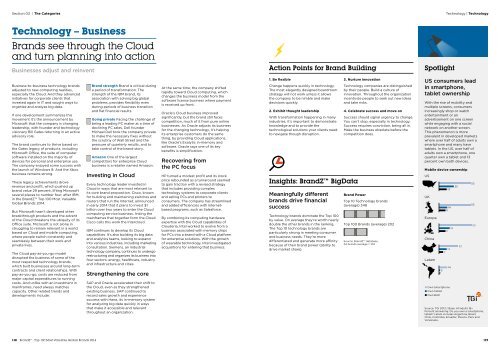download-report
download-report
download-report
You also want an ePaper? Increase the reach of your titles
YUMPU automatically turns print PDFs into web optimized ePapers that Google loves.
Section 03 | The Categories<br />
Technology | Technology<br />
Technology – Business<br />
Brands see through the Cloud<br />
and turn planning into action<br />
Businesses adjust and reinvent<br />
Action Points for Brand Building<br />
Spotlight<br />
Business-to-business technology brands<br />
adjusted to new computing realities,<br />
especially the Cloud. And they advanced<br />
initiatives for corporate clients that<br />
invested again in IT and sought ways to<br />
organize and analyze big data.<br />
If one development summarizes this<br />
movement it’s the announcement by<br />
Microsoft that the company is changing<br />
leadership, with founder and technology<br />
visionary Bill Gates returning in an active<br />
advisory role.<br />
The brand continues to thrive based on<br />
the Gates legacy of products, including<br />
Microsoft Office, the suite of computer<br />
software installed on the majority of<br />
devices for personal and enterprise use.<br />
The company enjoyed some success with<br />
the launch of Windows 8. And the Xbox<br />
business remains strong.<br />
These legacy achievements drove<br />
revenue and profit, which pushed up<br />
brand value 29 percent, lifting Microsoft<br />
several places to number four, after IBM,<br />
in the BrandZ Top 100 Most Valuable<br />
Global Brands 2014.<br />
But Microsoft hasn’t developed other<br />
breakthrough products and the advent<br />
of the Cloud threatens the ubiquity of its<br />
Office suite. Microsoft is not alone in<br />
struggling to remain relevant in a world<br />
based on Cloud and mobile computing,<br />
where people switch constantly and<br />
seamlessly between their work and<br />
private lives.<br />
The Cloud pay-as-you-go model<br />
disrupted the business of some of the<br />
most respected technology brands,<br />
which built businesses around long-term<br />
contracts and client relationships. With<br />
pay-as-you-go, costs are reduced from<br />
major capital expenditures to running<br />
costs. And unlike with an investment in<br />
mainframes, need always matches<br />
capacity. Other related trends and<br />
developments include:<br />
Brand strength Brand is critical during<br />
a period of transformation. The<br />
strength of the IBM brand, its<br />
association with solving big global<br />
problems, provides flexibility even<br />
during periods of business transition<br />
and flat financial results.<br />
Going private Facing the challenge of<br />
being a leading PC maker at a time of<br />
declining PC sales, Dell founder<br />
Michael Dell took the company private<br />
to make the necessary fixes without<br />
the scrutiny of Wall Street and the<br />
pressure of quarterly results, and to<br />
take control of the brand story.<br />
Amazon One of the largest<br />
competitors for enterprise Cloud<br />
business is a retailer named Amazon.<br />
Investing in Cloud<br />
Every technology leader invested in<br />
Cloud in ways that are most relevant to<br />
its core brand proposition. Cisco, known<br />
for building and maintaining switches and<br />
routers that run the Internet, announced<br />
in early 2014 that it plans to invest $1<br />
billion over two years to enter the Cloud<br />
computing service business, linking the<br />
mainframes that together form the Cloud.<br />
Cisco calls this work the Intercloud.<br />
IBM continues to develop its Cloud<br />
capabilities. It’s also building its big data<br />
and analytics teams, looking to expand<br />
into various industries, including marketing<br />
consultation. Siemens, an industrial<br />
technology company, continues to undergo<br />
restructuring and organizes its business into<br />
four sectors: energy, healthcare, industry<br />
and infrastructure and cities.<br />
Strengthening the core<br />
SAP and Oracle accelerated their shift to<br />
the Cloud, even as they strengthened<br />
existing business. SAP continued to<br />
record sales growth and experience<br />
success with Hana, its in-memory system<br />
for analyzing big data quickly in ways<br />
that make it accessible and relevant<br />
throughout an organization.<br />
At the same time, the company shifted<br />
rapidly toward Cloud computing, which<br />
changes the business model from the<br />
software license business where payment<br />
is received up front.<br />
Oracle’s Cloud business improved<br />
significantly, but the brand still faces<br />
competition, much of it from pure online<br />
businesses. As Oracle adjusts its business<br />
for the changing technology, it’s helping<br />
its enterprise customers do the same<br />
thing, by providing Cloud applications,<br />
like Oracle’s Exalytic in-memory and<br />
software. Oracle says one of its key<br />
benefits is simplification.<br />
Recovering from<br />
the PC focus<br />
HP turned a modest profit and its stock<br />
price rebounded as a turnaround seemed<br />
to gain traction with a revised strategy<br />
that includes providing complex<br />
technology systems to corporate clients<br />
and selling PCs and printers to<br />
consumers. The company has streamlined<br />
and added efficiencies with Internetbased<br />
programs, such as Salesforce.<br />
By combining its computing hardware<br />
expertise with the Cloud capabilities of<br />
Clouderia, Intel worked to evolve from a<br />
business associated with memory chips<br />
for PCs into a brand with a Cloud platform<br />
for enterprise solutions. With the growth<br />
of wearable technology, Intel investigated<br />
acquisitions for entering that business.<br />
1. Be flexible<br />
Change happens quickly in technology.<br />
The most elegantly designed boardroom<br />
strategy will not work unless it allows<br />
the company to be nimble and make<br />
decisions quickly.<br />
2. Exhibit thought leadership<br />
With transformation happening in many<br />
industries, it’s important to demonstrate<br />
knowledge and to provide the<br />
technological solutions your clients need<br />
to navigate though disruption.<br />
Insights: BrandZ BigData<br />
Meaningfully different<br />
brands drive financial<br />
success<br />
Technology brands dominate the Top 100<br />
by value. On average they’re worth nearly<br />
double the other brands in the ranking.<br />
The Top 10 technology brands are<br />
particularly strong in meeting consumer<br />
and business needs. They’re more<br />
differentiated and generate more affinity<br />
because of their brand power (ability to<br />
drive market share).<br />
3. Nurture innovation<br />
Technology companies are distinguished<br />
by their people. Build a culture of<br />
innovation. Throughout the organization<br />
incentivize people to seek out new ideas<br />
and take risks.<br />
4. Celebrate success and move on<br />
Success should signal urgency to change.<br />
You can’t stop, especially in technology.<br />
Success requires conviction, being all in.<br />
Make the business obsolete before the<br />
competition does.<br />
Brand Power<br />
Top 10 Technology brands<br />
(average) 348<br />
Top 100 Brands (average) 202<br />
Source: BrandZ database<br />
All brands average = 100<br />
US consumers lead<br />
in smartphone,<br />
tablet ownership<br />
With the rise of mobility and<br />
multiple screens, consumers<br />
increasingly shop or watch<br />
entertainment or an<br />
advertisement on one screen<br />
while engaging with a social<br />
network on another screen.<br />
This phenomenon is more<br />
prevalent in developed markets<br />
where over half of adults own a<br />
smartphone and many have<br />
tablets. In the US, over half of<br />
adults own a smartphone, one<br />
quarter own a tablet and 13<br />
percent own both devices.<br />
Mobile device ownership<br />
US<br />
UK<br />
Europe<br />
China<br />
Latam<br />
2<br />
1<br />
7<br />
13<br />
14<br />
11<br />
11<br />
13<br />
14<br />
Own Smartphone<br />
Own Tablet<br />
Own Both<br />
18<br />
25<br />
32<br />
53<br />
53<br />
55<br />
Source: TGI 2013 / Base: All adults 18+<br />
Percent answering: Do you own a smartphone,<br />
tablet? Latam includes Argentina, Brazil,<br />
Chile, Colombia, Ecuador, Mexico, Peru and<br />
Venezuela.<br />
118 BrandZ Top 100 Most Valuable Global Brands 2014 119



